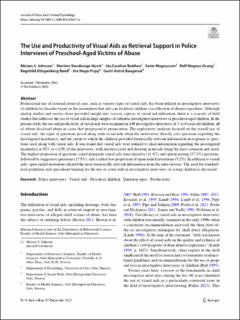The Use and Productivity of Visual Aids as Retrieval Support in Police Interviews of Preschool-Aged Victims of Abuse
Johnson, Miriam S.; Hyvik, Martine Stordrange; Bråthen, Ida Caroline; Magnussen, Svein; Grung, Rolf Magnus; Røed, Ragnhild Klingenberg; Pripp, Are Hugo; Baugerud, Gunn Astrid
Peer reviewed, Journal article
Published version
Permanent lenke
https://hdl.handle.net/11250/3115246Utgivelsesdato
2023Metadata
Vis full innførselSamlinger
Originalversjon
10.1007/s11896-023-09627-wSammendrag
Professional use of external retrieval cues, such as various types of visual aids, has been utilized in investigative interviews of children for decades based on the assumption that aids can facilitate children’s recollection of abusive incidents. Although analog studies and surveys have provided insight into various aspects of visual aid utilization, there is a scarcity of field studies that addresses the use of visual aids in large samples of authentic investigative interviews of preschool-aged children. In the present study, the use and productivity of visual aids were examined in 140 investigative interviews of 3- to 6-year-old children, all of whom disclosed abuse in cases that progressed to prosecution. The exploratory analyses focused on the overall use of visual aids, the types of questions posed along with visual aids when the interviewer directly asks questions regarding the investigated incident(s), and the extent to which the children provided forensically relevant information in response to questions used along with visual aids. It was found that visual aids were utilized to elicit information regarding the investigated incident(s) in 92% (n = 129) of the interviews, with emotion cards and drawing materials being the most common aids used. The highest proportion of questions asked alongside visual aids were directive (41.6%) and option-posing (37.3%) questions, followed by suggestive questions (17.9%), and a rather low proportion of open-ended invitations (3.2%). In addition to visual aids, open-ended invitations elicited the most forensically relevant information from the interviewees. The need for standardized guidelines and specialized training for the use of visual aids in investigative interviews of young children is discussed.

